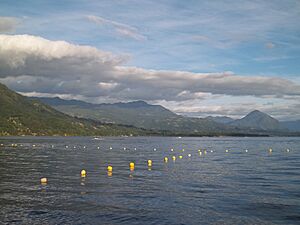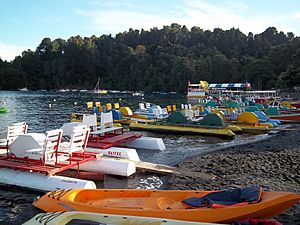Licán Ray facts for kids
Quick facts for kids
Licán Ray
Lican-Ray (Stone Flower)
|
|
|---|---|
|
Town
|
|
| Country | |
| Region | Araucania |
| Province | Cautín |
| Municipalidad | Villarrica |
| Commune | Villarrica |
| Government | |
| • Type | Municipality |
| Population
(2002 census)
|
|
| • Total | 7,200 (updated to 2,012) |
| Time zone | UTC−04:00 (Chilean Standard) |
| • Summer (DST) | UTC−03:00 (Chilean Daylight) |
| Area code(s) | Country + town = 56 + ? |
| Website | villarrica.org |

Licán Ray is a beautiful town and resort in Chile. It sits on the north shore of Calafquén Lake. The town is about 27 kilometers from Villarrica city. It is part of the Villarrica commune in the Cautín Province of the Araucanía Region.
Licán Ray is a popular place for tourists. About 7,200 people live there (as of 2012). The town's name comes from Mapudungun. This is the language of the Mapuche people, who are native to Chile. "Licán Ray" means "Stone Flower". You might see the name written in a few ways, like Lican Ray, Licanray, or Licán-Ray.
Contents
History of Licán Ray
The Legend of Stone Flower
There is an old story about how Licán Ray got its name. It tells of a girl named Licán Ray, meaning "Stone Flower". She was the daughter of a powerful Cacique (a Mapuche chief) named Carilef.
Licán Ray fell in love with a Spanish sailor. They ran away together to escape her father's anger. They hid on one of the islands in Calafquén Lake. When they got cold, they lit a fire. But the fire showed their hiding spot. So, they had to move to another island. This happened many times. Each time they made a fire, their pursuers found them. They sailed to all 11 islands until their pursuers finally lost them. The area was then named Licán Ray to remember the daughter.
Early Days and Growth
Licán Ray does not have an exact founding date. People believe the town started to grow in the 1930s. It was officially recorded in the city of Valdivia on February 15, 1944.
In 1942, the government loaned land to the State Train Company. This company harvested oak wood to make railroad ties. Their work brought more people and activity to the town. The company used a ship to transport wood across the lake. This ship also helped people travel.
Changes and Development
By 1948, the company had used up most of the oak trees nearby. So, they left the town. Another private company came to take over the wood business. But they only stayed until 1952. After this, the town's economy slowed down.
There were plans to build a dam that would have put the town 14 meters underwater. But this plan changed after the big 1960 Valdivia earthquake. Instead, the Pullinque hydropower plant was built in 1962. It was built in Pullinque Lake.
In 1966, the government sold or gave away land. This was to help build houses and places for tourists to stay. It helped the local economy grow and develop the area. In 1990, the road connecting Villarrica to Licán Ray was finally paved. This made it much easier for tourists to visit. It gave a big boost to the local tourism industry.
Fun Places to Visit in Licán Ray
The main reason people visit Licán Ray is its amazing natural beauty. You can see beautiful lakes, tall mountains, volcanoes, and native forests.
- Calafquén Lake: This lake is 209 meters above sea level. It covers a large area of 120 square kilometers. It has 11 islands! This long, thin lake is perfect for outdoor activities. You can go fishing or enjoy watersports.
- Península Natural Park: This is a 15.5-hectare park on a peninsula that goes into the lake. The local Mapuche community takes care of it. It's a great place to see native trees. These include the Arrayán (Chilean myrtle) and Lingue.
- Playa Grande (Large Beach): This beach stretches from the north side of the peninsula to the Malpun stream. It has soft volcanic sand. Many outdoor activities start from this beach.
- Playa Chica (Small Beach): This beach goes from the south side of the peninsula to the fisherman's cove. It's a good spot for sailing.
- El Escorial: This is a petrified lava river. It was formed by the 1977 eruption of Villarrica Volcano. Today, you can walk along this amazing stone river.
- Local Markets and Squares: You can visit the Artisan Markets, Plaza de Armas (main square), and Plaza San Francisco. These are all in the town. They are popular places to see local buildings, culture, and traditions.
- The Promenade: This walkway is at the start of Playa Chica. It is lined with colorful boats. You can rent some of these boats to explore the lake or swim in the waters.
See also
 In Spanish: Lican Ray para niños
In Spanish: Lican Ray para niños



